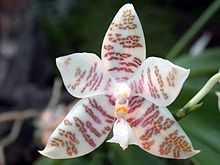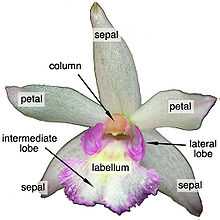Phalaenopsis hieroglyphica
| Phalaenopsis hieroglyphica | |
|---|---|
 | |
| Phalaenopsis hieroglyphica | |
| Scientific classification | |
| Kingdom: | Plantae |
| (unranked): | Angiosperms |
| (unranked): | Monocots |
| Order: | Asparagales |
| Family: | Orchidaceae |
| Subfamily: | Epidendroideae |
| Genus: | Phalaenopsis |
| Subgenus: | Polychilos |
| Species: | P. hieroglyphica |
| Binomial name | |
| Phalaenopsis hieroglyphica (Rchb.f.) H.R.Sweet | |
| Synonyms | |
| |
The ornamental orchid species Phalaenopsis hieroglyphica (/fælɨˈnɒpsɨs haɪərɵˈɡlɪfɨkə/ fal-ə-NOP-sis hyr-o-GLIF-i-kə) is native to certain islands of The Philippines. Its flowers are creamy white with transverse markings that resemble glyphs.[1] Through hybridization, growers have successfully created flowers with different shapes and colors while retaining the glyphs. Since 1975, the species has been protected under Appendix II of the Convention on International Trade in Endangered Species of Wild Fauna and Flora (CITES).[2][3]
Growth, habitat and cultivation

Commonly P. hieroglyphica blooms in spring, with three to four star-shaped flowers that open simultaneously and last two to three months; a well-established specimen with keikis can produce more than 50 flowers. Their fragrance is said to be faintly rose-like[4] or strongly citrus-like.[5] The background of the flower can be white to ochre, sometimes with a tinge of green at the tips, and the glyphs on the sepals and stamens can be cinnamon or a purple hue.[6] The flowers are comparatively larger and the glyphs more pronounced than those of P. lueddemanniana.[7] The characteristic glyphs are retained in P. hieroglyphica hybrids.
As a monopodial epiphyte, it is found growing on and hanging down from trees in shady locations on the islands of Polillo, Palawan, Mindanao (in Surigao del Norte and Surigao del Sur) and Luzon at elevations below 1700 feet (500 meters). Of its genus, this species grows in the coolest and deeply shady locations of humid forests.[8] Not much is known about its natural habitat, including its pollinators.[9]
The species was first cultivated in England by Hugh Low & Company from a specimen delivered by collector William Boxall[10] in 1887.
Since 1975 this species has been considered vulnerable to extinction and listed in Appendix II of the Convention on International Trade in Endangered Species of Wild Fauna and Flora (CITES). To protect against overcollection, an export permit is required in international trade of specimens taken from their natural habitat.[11] Protection from loss and degradation of the natural habitat are also concerns.[8]
Taxonomy
The accepted synonym Phalaenopsis lueddemanniana var. hieroglyphica reflects its naming in 1887 by German orchidologist H. G. Reichenbach.[12][13] In 1969, American botanist H. R. Sweet elevated its ranking to species.[14] The accepted synonym Polychilos hieroglyphica is traced to Malaysian botanist Shim in 1982.[15]
The morphological characteristics of P. hieroglyphica reported by H. R. Sweet [16] and Eric A. Christenson[17] point to species classification and intragenus relationships confirmed by DNA analysis findings published in 2009.[18]
Anatomy of Phalaenopsis

In the epiphytes of Phalaenopsis, moisture is stored primarily in the leaves and photosynthesis-generating sugar primarily in the fleshy roots. In Phalaenopsis species with horizontal stems, such as P. hieroglyphica, the leaves are pendant and grow downward to drain rainwater away from the plant. The reproductive organ is the column, found between the two largest petals of Phalaenopsis orchids. The lip, connected to the flower by the column, aids in pollination. The lip in all Phalaenopsis orchids has three lobes, as depicted in a general orchid flower diagram (left). In the seminal work Fertilisation of Orchids, Charles Darwin detailed these and other observable characteristics of orchid specimens, including Phalaenopsis species, to determine biological mechanisms of species adaptation, survival and ecological relationships.
Leaf: oblong and leather-like, up to 12 inches (30 cm) long and 2.5 inches (6.35 cm) wide, tapering to the base, acute or obtuse at the tip
Inflorescence: from arching to suberect, raceme or panicle, up to 13 inches (32 cm) long and many-flowered, with ovate to hooded bracts up to .2 inches (0.5 cm) long, appearing on the stem which emerges between the leaves
Flower: star-shaped, up to 2 to 3.5 inches (5 to 8.75 cm), with transverse barring on the sepals and petals
Labellum or Lip: three-lobed, up to 1 inch (2.5 cm) long and 0.75 inch (1.8 cm) wide, lateral lobes being cleft and oblong, the intermediate or mid-lobe being oblanceolate to obtuse with a raised central ridge covered with trichomes
Dorsal sepal: elliptic, inward-sloping, up to 1.5 inches (3.8 cm) long and 0.69 inch (1.5 cm) wide
Lateral sepal: obliquely oblong to elliptic and tapering, channeled along the midvein, up to 1.6 inches (4.1 cm) long and less than 0.75 inches (1.7 cm) wide
Petal: ovate to elliptic, wedge-shaped, up to 1.3 inch (3.3 cm) long and 0.6 inch (1.6 cm) wide
Column: cyllindrical and slightly arching, up to 0.5 inch (1.2 cm) long
Pedicel and ovary: up to 0.75 inch long
References
Notes
- ↑ "Glyph". Whatis.com. Retrieved 7 June 2013.
- ↑ UNEP-WCMC. "UNEP-WCMC Species Database: CITES-Listed Species". Retrieved 15 June 2013. See also: [UNEP] World Conservation Monitoring Centre (2010). 2003 Checklist of CITES Species (digitized). Cambridge, UK: CITES Secretariat/World Conservation Monitoring Centre. p. 302. ISBN 1 899 628 088. Retrieved 15 June 2013.
- ↑ Department of Environment and Natural Resources. "2004 Statistics on Philippine Protected Areas and Wildlife Resources" (pdf). Protected Areas and Wildlife Bureau, The Philippines. Retrieved 23 June 2013.
- ↑ Frowine, National Gardeners Association, Steven A (September 14, 2011). Orchids for Dummies (Google eBook). Hoboken, NJ (USA): Wiley Publishing, Inc. p. 133. ISBN 0-7645-6759-4. Retrieved 13 June 2013.
- ↑ Ikedo, Tsuneo. "Morphology, Regional Difference and Taxonomy". Phalaenopsis Species: Ecology, Morphology and Cultivation. Retrieved 3 July 2013.
- ↑ Mirenda, Thomas; Osen, James (August 2008). "Summer Phalaenopsis" (pdf). Genus of the Month Bulletin (American Orchid Society): 584.
- ↑ Frowine, Steven A. (2008). Moth Orchids: The complete guide to Phalaenopsis. Portland, OR (USA): Timber Press, Inc. p. 34. ISBN 978-0-88192-870-9.
- ↑ 8.0 8.1 "Phalaenopsis hieroglyphica". Biodiversity Information Sharing Service (ASEAN Clearing House Mechanism). ASEAN Centre for Biodiversity. Retrieved 18 June 2013.
- ↑ Christenson, Eric (2001). Phalaenopsis: A Monograph. Portland, OR (USA): Timber Press, Inc. pp. 292–93. ISBN 978-0881924947.
- ↑ For a profile of Boxall's work as a "veteran orchidist," see: "Obituary". The Orchid Review. November 1910. Retrieved 1 July 2013.
- ↑ Ikedo, Tsuneo. "Procurement of Phalaenosis[sic] Species". Phalaenopsis Species: Ecology, Morphology and Cultivation. Retrieved 2 July 2013.
- ↑ See Reichenbach, H. G. (1887). "Phalaenopsis lüeddemanniana, var. hierogphyphica, n. var.". Gardeners Chronicle. 3 (2): 586. Retrieved 16 June 2013.
- ↑ Cootes, Jim; Banks, David P., Titmuss, David (2001). The Orchids of the Philippines (hardbound ed.). Portland, Or.: Timber Press. p. 155. ISBN 978-0881925166.
- ↑ See Sweet, Herman Royden (1969). "P. lueddemanniana var. hieroglyphica". American Orchid Society Bulletin 38: 36.
- ↑ See Shim, Phyau Soon (1982). Malayan National Journal 36 (1): 23.
- ↑ Sweet, Herman R[oyden] (1980). The Genus Phalaenopsis (Orchids of the World Vol. 1 ed.). [S.I.]: The Orchid Digest Inc.
- ↑ Christenson, Eric A. (2001). Phalaenopsis: A Monograph. Portland, OR (USA): Timber Press, Inc. pp. 128–30. ISBN 978-0881924947.
- ↑ Niknejad, A.; Kadir, M. A., Kadzimin, S. B., Abdullah, N. A. P and Sorkheh, K. (October 19, 2009). "Molecular characterization and phylogenetic relationships among and within (Epidendroideae: Orchidaceae) based on RAPD analysis". African Journal of Biotechnology 8 (20): 5225–40. ISSN 1684-5315.
Further reading
- Boosey, Jane. 2007. 300 Orchids: Species, Hybrids and Varieties in Cultivation. Buffalo, NY (USA) and Ontario, Canada: Firefly Books Ltd. ISBN 978-1554072965. See p406 for brief morphology.
- Cootes, Jim. 2001. The Orchids of The Philippines. Portland, OR (USA): Timber Press, Inc. ISBN 978-0881925166. See p156 for brief morphology.
External links
-
 Media related to Phalaenopsis hieroglyphica at Wikimedia Commons
Media related to Phalaenopsis hieroglyphica at Wikimedia Commons -
 Data related to Phalaenopsis hieroglyphica at Wikispecies
Data related to Phalaenopsis hieroglyphica at Wikispecies - Varieties of Phalaenopsis hieroglyphica
- Google Images of Phalaenopsis hieroglyphica
- American Orchid Society Phalaenopsis for Beginners
- American Orchid Society Phalaenopsis information
- Missouri Botanical Garden information
- Picsearch images
- Epidendra: The Global Orchid Taxonomic Network (at the University of Costa Rica)